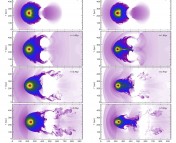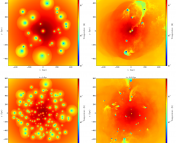Title: The Three Hundred Project: Ram pressure and gas content of haloes and subhaloes in the phase-space plane
Authors: Jake Arthur, Frazer R. Pearce, Meghan E. Gray et al.
First Author’s Institution: School of Physics & Astronomy, University of Nottingham, UK
Status: Published in MNRAS, open access on arXiv
Why do galaxies come in different shapes, sizes and colours? What are the physical processes that determine a galaxy’s observable properties? These questions drive extragalactic astrophysics. One factor in a galaxy’s evolution that is under scrutiny is the environment it is found in. Depending on whether a galaxy is located in a dense cluster or is relatively isolated in the field, the physical processes that shape it will differ. There is an observable difference in colour and morphology of galaxies depending on their environments: in the densest environments, galaxies tend to be red and elliptical, whereas in low-density environments we find many more blue spirals. Why?
In this paper, the authors investigate what happens in and around galaxy clusters, the largest gravitationally-bound structures in the universe. Such structures grow over time as galaxies fall into their gravitational potential, and during this infall a galaxy can be transformed. In the space between galaxies, a cluster isn’t empty — it’s filled with hot gas (the “intra-cluster medium”), which exerts a pressure on a galaxy falling through it. The resulting wind can blow gas out of the galaxy in a process known as ram pressure stripping. In fact, this process is observed spectacularly in jellyfish galaxies, with tentacles of gas trailing behind the galactic disk. Stripping a galaxy of its gas prevents it from forming stars, thus changing the colour from the blue of young stellar populations to the red of older stars — and so ram pressure stripping is a favoured mechanism behind the blue galaxies in the field vs. red galaxies in clusters problem.
To study how and when this happens, the authors of this paper use a suite of over three hundred simulations of galaxy clusters (figure 1 shows an example). These simulations deal with haloes — clumps of gravitationally-bound matter — rather than galaxies themselves, but halo properties tell us about what would happen to galaxies residing in them.
The beauty of simulations is that each cluster can be examined in three dimensions, with a complete understanding of where each infalling halo is and how it is moving. The authors are working in six dimensions: the x, y and z positions of each halo, and the velocities in each of those dimensions.
In reality, we can only observe a galaxy cluster from one angle, along the line of sight that it falls upon viewing it from our position in the universe. This gives us two dimensions in position and a third in line-of-sight velocity. We have to deal with projection effects that make it very difficult to understand exactly how a galaxy is moving. A particular observational challenge arises from “backsplash” galaxies: as a galaxy falls into a cluster, it doesn’t immediately settle in the cluster potential, but will pass through with a velocity taking it out the other side to swing back on a second pass. Figure 2 shows a schematic of this in phase-space from the paper. Backsplash galaxies have already passed through the dense cluster core, and therefore experienced dynamical effects such as ram pressure stripping, but they are located outside the cluster in the same space as the freshly infalling galaxies. This makes an observational sample of true, first-time infallers very difficult to select.
To investigate how their galaxy clusters would look in reality, the authors also show the projected positions and velocities along a single line of sight alongside the 6D data, making a comparison of the simulations with observations. Infalling haloes are plotted in phase space similarly to figure 1, color-coded to show their gas fractions (figure 3). Haloes are found to lose their gas very quickly on their first infall into the cluster: evolutionary effects occur before the galaxy gets even close to the cluster centre.
The authors investigate a number of other effects, such as the ram pressure at each point on the infall, and the behaviour of “sub-haloes” within haloes which are shown to lose their gas even more rapidly. Their results point to a scenario of complex evolution happening in the early stages of encounters, with galaxies rushing towards massive clusters being efficiently stripped of their gas on the way in.
The line of sight plots show that from observations alone it is very difficult to determine when and how infalling galaxies lose their gas. However, by combining observations with the 6D information from the simulations, a clearer picture emerges of galaxy evolution around massive clusters. The group’s future work entails using the other wonderful aspect of simulations — the ability to look across time — enabling them to follow the evolution of individual haloes on their journeys into clusters. The Three Hundred looks like an exciting project to watch!




